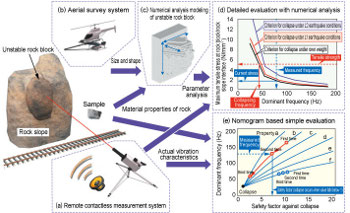20. System for evaluating the stability of rock slopes using remote-contactless measurements
In order to prevent rockfalls from rock slopes adjacent to railway lines, it is necessary to identify unstable rock blocks and take preventive action. A method was therefore developed to enable the safe and efficient assessment of the stability slopes in hard-to-access, isolated or high-up locations (Figure 1).
The contactless vibration measuring system (Figure 1-a) can detect micro-tremors on a rock face using red or infrared laser beams at distances of ten to several hundred meters. Where possible, unstable rock block vibration characteristics are evaluated on the basis of ordinary micro-tremor data, while stable rock blocks with vibration characteristics which do not appear clearly from ordinary micro-tremor data are examined using acoustic vibration etc.
The aerial survey system (Figure 1–b) comprises a camera-mounted radio controlled helicopter, which flies around the target rock block collecting data about its shape from aerial photographs. This data is used to semi-automatically create a FEM analysis model of the rock block (Figure 1-c).
This research offers two safety evaluation methods, one through numerical analysis, based on the dominant frequency of the boulder obtained from vibration measurements and on an FEM analysis model, which offers detailed stability assessment under normal conditions and in case of an earthquake (Figure 1-d); the other simpler evaluation method uses the dominant frequency to determine a falling safety factor in relation to the rock block’s boulder’s stability against collapse in nomogram form (Figure 1-e).
Other Contents
- 18. Renovation technology for large scale station widening work
- 19. System for monitoring soundness of railway bridges
- 20. System for evaluating the stability of rock slopes using remote-contactless measurements
- 21. Track maintenance planning systems applying very frequently measured track irregularity data
- 22. Rail gas pressure welding process applicable without specialist welding skills
- 23. Updating of on-board train safety database using wireless technology
- 24. Device for determining AC feeder lightening arrester damage
- 18. Renovation technology for large scale station widening work
- 19. System for monitoring soundness of railway bridges
- 20. System for evaluating the stability of rock slopes using remote-contactless measurements
- 21. Track maintenance planning systems applying very frequently measured track irregularity data
- 22. Rail gas pressure welding process applicable without specialist welding skills
- 23. Updating of on-board train safety database using wireless technology
- 24. Device for determining AC feeder lightening arrester damage

